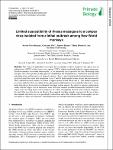Limited susceptibility of rhesus macaques to a cowpox virus isolated from a lethal outbreak among New World monkeys
Mätz-Rensing, Kerstin
Yue, Constanze
Klenner, Jeanette
Ellerbrok, Heinz
Stahl-Hennig, Christiane
This study was undertaken to investigate the susceptibility of rhesus monkeys to the calpox virus, an orthopoxvirus (OPXV) of the Cowpox virus species (CPXV), which is uniformly lethal in common marmosets. Six rhesus monkeys were either intravenously (i.v.) or intranasally (i.n.) exposed to the virus. Monitoring of the macaques after viral exposure included physical examinations, the determination of viral load by real-time PCR and plaque assay, and the analysis of humoral responses. Two i.v. inoculated animals developed numerous classical pox lesions that started after inoculation at days 7 and 10. Both animals became viremic and seroconverted. They exhibited maximal numbers of lesions of approximately 50 and 140 by day 21. One animal completely recovered, while the other one suffered from a phlegmonous inflammation of a leg initially induced by a secondarily infected pox lesion and was euthanized for animal welfare reasons. In contrast to previous pathogenicity studies with the calpox virus in marmosets, none of the four animals inoculated intranasally with doses of the calpox virus exceeding those used in marmosets by orders of magnitude showed typical clinical symptoms. No viral DNA was detectable in the blood of those animals, but three animals seroconverted. In two of these three animals, infectious virus was sporadically isolated from saliva. This indicates that rhesus monkeys are less susceptible to calpox virus infection, which limits their use in further intervention studies with OPXV.
No license information

